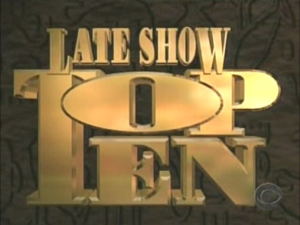I hate long flights, but here I am somewhere over Kansas wishing that I could click my heels and be home. I am on my way back from California–without a first class upgrade–flying to Council of Supply Chain Management Professionals (CSCMP) sitting elbow to elbow with new “friends” thinking about my week.
 So many people wrote me questions on the presentation that I presented at the S&OP IE event and posted on SlideShare this week (Reference powerpoint posted on Slideshare at http://www.slideshare.net/loracecere/sop-ie-event-january-2011) that I decided to tackle a few here in a blog–Lora’s Top Five of the TOP TEN– in between lift off and touch down. Due to space limitations, I am going to limit this blog to the top five questions only.
So many people wrote me questions on the presentation that I presented at the S&OP IE event and posted on SlideShare this week (Reference powerpoint posted on Slideshare at http://www.slideshare.net/loracecere/sop-ie-event-january-2011) that I decided to tackle a few here in a blog–Lora’s Top Five of the TOP TEN– in between lift off and touch down. Due to space limitations, I am going to limit this blog to the top five questions only.
Tackling the Top Five of the TOP TEN List
I will never be David Letterman, but I like the concept of a TOP TEN list. So, at the recent, S&OP IE event in Boston, I decided to liven it up a bit and play David Letterman. I shared my TOP TEN list. Lora’s TOP TEN list represents the most commonly asked questions asked over the period of seven years in work with clients on Sales and Operations Planning (S&OP). During this period, I have shared insights with over 250 supply chain leaders on process, technology and organizational evolution to improve operational results. As an analyst, the advice comes in the form of inquiry. Companies call you and ask questions. I have logged the questions. Here are the most common:
What is the ROI?
In qualitative interviews, as an analyst, it is hard to get a team to give you a definitive ROI. So, I structure the questions a bit differently:
- Where have you seen improvement?
- Can you quantify the improvement in your operations?
Surprisingly, for many, the greatest benefit of S&OP is growth not cost reduction. In the chart below, the numbers to the right represent the frequency of mention and the numbers on the arrow represent the magnitude of improvement. While companies will often start an S&OP project to improve efficiency and reduce costs, a powerful driver of S&OP is GROWTH. It takes two forms: improved fulfillment and better execution of new product launch.

What is the best Reporting Structure?
The best reporting structure is to have the S&OP team report to the profit center manager. The profit center manager is the natural choice to make decisions between the go-to-market strategies of the “S” and the operational considerations of the “OP”. However, in about 1/2 of the organizations that I work with this answer is not sufficient. Either there is no profit center manager between the team and the CEO or the complexity of the matrix organization makes it unclear who owns the final decision on profitability.
So, I then recommend the next best thing: a neutral group that works between the go-to-market groups of sales/marketing and operations. This can be a strategy group, a finance group or a special team working for the CEO. What is CLEAR to me from the research sales & marketing are the WORST places for the teams to report to. The highest bias and error in forecasting happens when the team reports to sales. Likewise, these teams lack the discipline and balance to drive excellence in the process. The next worst team for reporting is marketing for similar reasons. The third worst place for S&OP to report is manufacturing. When the team reports to manufacturing, it is difficult for the group to gain enough clout to drive the process.
Do I need Technology?
Yes, spreadsheets are not sufficient. The team needs to start with software that helps to determine a “Feasible Plan”, and realize that these data models are not in the Office Suites of software.
Who does it Best?
The companies that do S&OP best have one of two characteristics: tight margins or a recent market failure. Either can be a rallying cry to get things right. I firmly believe that S&OP is the best process to align the organization horizontally across silos to a business strategy. The companies that do it best have a clear strategy and they understand from real-world experience that they cannot mess around. Good examples of this are Cisco and Dupont. Both companies failed to anticipate demand during recessions– Cisco in the 2002 recession and Dupont in the 2008 recession– resulting in disappointing earnings and the redefinition of S&OP processes. The fact that the first thing that both of these companies fixed when they failed was the S&OP process is a testimonial to the strength of the process.
What does Good Look Like?
Companies that do it best have seven characteristics: a clear strategy, alignment on the goal (see the next post Squeezed from Both Ends), a disciplined monthly process, a focus on continuous improvement and clarity on how to make decisions (governance model).
I hope this helps. Please let me know if you have any questions. My plane is on approach…..






